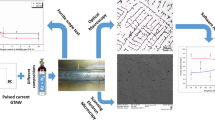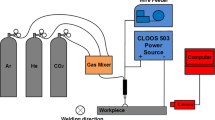Abstract
The mass transfer in shielded metal arc welding of a group of nickel-base alloy covered electrodes according to AWS specification A5.11-A5.11M was investigated by directly measuring their deposited metal compositions. The results indicate that the chromium mass-transfer coefficient is in the range of 86 to 94 pct, iron in the range of 82 to 89 pct, manganese in the range of 60 to 73 pct, niobium in the range of 44 to 56 pct, and silicon in the range of 41 to 47 pct. The metal mass-transfer coefficient from the core wire is markedly higher than that from the coating. The basicity of slag, the metal contents in the flux coating, and the welding current together affect the mass transfer. As the basicity of slag increases, the mass-transfer coefficients of Mn, Fe, and Cr slightly increase, but those of Nb and Si decrease significantly. As the niobium and manganese contents increase in the coating, their mass-transfer coefficients also increase. However, iron is different. The content of iron in the coating in the range of 8 to 20 wt pct results in the optimal effective mass transfer. The lower, or higher, iron content leads to lower mass-transfer coefficient. As the welding current increases, the mass-transfer coefficients of niobium and manganese decrease, but chromium and silicon increase. Iron has the lowest mass-transfer coefficient when welded under the operating current of 100 A.







Similar content being viewed by others
Notes
INCONEL is a trademark of Special Metals Corporation, New Hartford, NY.
References
S.D. Strauss: Power, 1996, vol. 140, pp. 29–30.
H.T. Lee, S.L. Jeng, C.H. Yen, and T.Y. Kuo: J. Nucl. Mater., 2004, vol. 335, pp. 59–69.
J. Adamiec: Mater. Charact., 2009, vol. 60, pp. 1093–99.
Md.I. Khan: Welding Science and Technology, 1st ed., New Age International Ltd., New Delhi, 2007, pp. 69–96.
J.N. DuPont, J.C. Lippold, and S.D. Kiser: Welding Metallurgy and Weldability of Nickel-Base Alloys, 1st ed., John Wiley & Sons, Inc., Hoboken, NJ, 2009, pp. 57–90.
Z. Zhang and S. Li: The Design, Manufacture and Selection of Covered Electrodes, 1st ed., Mechanical Industry Press, Beijing, 1998, pp. 145–210.
F.D. Richardson and J.H.E. Jeffes: J. Iron Steel Res. Int., 1948, vol. 160, pp. 261–70.
H.J.T. Ellingham: J. Soc. Chem. Ind., 1944, vol. 63, pp. 125–33.
N.N. Greenwood and A. Earnshaw: Chemistry of the Elements, 2nd ed., Butterworth–Heinemann, Oxford, 1997, pp. 328–61 and 1040–62.
K.C. Mills: ISIJ Int., 1993, vol. 33, pp. 148–55.
J.C. Lippold and D.J. Kotecki: Welding Metallurgy of Stainless Steels, 1st ed., John Wiley & Sons, Inc., Hoboken, NJ, 2005, pp. 173–200.
Author information
Authors and Affiliations
Corresponding author
Additional information
Manuscript submitted June 6, 2012.
Rights and permissions
About this article
Cite this article
Qin, R., He, G. Mass Transfer of Nickel-Base Alloy Covered Electrode During Shielded Metal Arc Welding. Metall Mater Trans A 44, 1475–1484 (2013). https://doi.org/10.1007/s11661-012-1505-x
Published:
Issue Date:
DOI: https://doi.org/10.1007/s11661-012-1505-x




